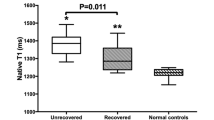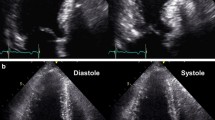Abstract
Peripartum cardiomyopathy (PPCM) is a rare cause of heart failure. Only half of the patients recover normal cardiac function. We assessed the usefulness of magnetic resonance imaging (MRI) and late enhancement imaging to detect myocardial fibrosis in order to predict cardiac function recovery in patients with peripartum cardiomyopathy. Among a consecutive series of 1,037 patients referred for heart failure treatment or prognostic evaluation between 1999 and 2006, eight women had confirmed PPCM. They all underwent echocardiography and cardiac MRI for assessment of left ventricular anatomy, systolic function and detection of myocardial fibrosis through late enhancement imaging. Mean (± SD) baseline left ventricular ejection fraction (LVEF) was 28 ± 4%. After a follow-up of 50 ± 9 months, half the patients recovered normal cardiac function (LVEF = 58 ± 4%) and four did not (LVEF = 35 ± 6%). None of the eight patients exhibited abnormal myocardial late enhancement. No difference in MRI characteristics was observed between the two groups. Patients with PPCM do not exhibit a specific cardiac MRI pattern and particularly no myocardial late enhancement. It suggests that myocardial fibrosis does not play a major role in the limitation of cardiac function recovery after PPCM.


Similar content being viewed by others
References
Fett JD, Christie LG, Carraway RD, Murphy JG (2005) Five-year prospective study of the incidence and prognosis of peripartum cardiomyopathy at a single institution. Mayo Clin Proc 80:1602–1606
Pearson GD, Veille JC, Rahimtoola S, Hsia J, Oakley CM, Hosenpud JD, Ansari A, Baughman KL (2000) Peripartum cardiomyopathy: National Heart, Lung, and Blood Institute and Office of Rare Diseases (National Institutes of Health) workshop recommendations and review. Jama 283:1183–1188
Lamparter S, Pankuweit S, Maisch B (2007) Clinical and immunologic characteristics in peripartum cardiomyopathy. Int J Cardiol 118:14–20
Elkayam U, Akhter MW, Singh H, Khan S, Bitar F, Hameed A, Shotan A (2005) Pregnancy-associated cardiomyopathy: clinical characteristics and a comparison between early and late presentation. Circulation 111:2050–2055
Sutton MS, Cole P, Plappert M, Saltzman D, Goldhaber S (1991) Effects of subsequent pregnancy on left ventricular function in peripartum cardiomyopathy. Am Heart J 121:1776–1778
Melvin KR, Richardson PJ, Olsen EG, Daly K, Jackson G (1982) Peripartum cardiomyopathy due to myocarditis. N Engl J Med 307:731–734
Midei MG, DeMent SH, Feldman AM, Hutchins GM, Baughman KL (1990) Peripartum myocarditis and cardiomyopathy. Circulation 81:922–928
Rizeq MN, Rickenbacher PR, Fowler MB, Billingham ME (1994) Incidence of myocarditis in peripartum cardiomyopathy. Am J Cardiol 74:474–477
Demakis JG, Rahimtoola SH (1971) Peripartum cardiomyopathy. Circulation 44:964–968
Lampert MB, Lang RM (1995) Peripartum cardiomyopathy. Am Heart J 130:860–870
Pennell DJ, Sechtem UP, Higgins CB, Manning WJ, Pohost GM, Rademakers FE, van Rossum AC, Shaw LJ, Yucel EK (2004) Clinical indications for cardiovascular magnetic resonance (CMR): Consensus Panel report. Eur Heart J 25:1940–1965
Mahrholdt H, Wagner A, Judd RM, Sechtem U, Kim RJ (2005) Delayed enhancement cardiovascular magnetic resonance assessment of non-ischaemic cardiomyopathies. Eur Heart J 26:1461–1474
Park S, Choi BW, Rim SJ, Shim CY, Ko YG, Kang SM, Ha JW, Jang Y, Chung N, Choe KO, Cho SY (2006) Delayed hyperenhancement magnetic resonance imaging is useful in predicting functional recovery of nonischemic left ventricular systolic dysfunction. J Card Fail 12:93–99
Assomull RG, Prasad SK, Lyne J, Smith G, Burman ED, Khan M, Sheppard MN, Poole-Wilson PA, Pennell DJ (2006) Cardiovascular magnetic resonance, fibrosis, and prognosis in dilated cardiomyopathy. J Am Coll Cardiol 48:1977–1985
Kaandorp TA, Lamb HJ, Bax JJ, Boersma E, Viergever EP, van der Wall EE, de Roos A (2005) Prediction of beneficial effect of beta blocker treatment in severe ischaemic cardiomyopathy: assessment of global left ventricular ejection fraction using dobutamine stress cardiovascular magnetic resonance. Heart 91:1471–1472
McCrohon JA, Moon JC, Prasad SK, McKenna WJ, Lorenz CH, Coats AJ, Pennell DJ (2003) Differentiation of heart failure related to dilated cardiomyopathy and coronary artery disease using gadolinium-enhanced cardiovascular magnetic resonance. Circulation 108:54–59
Messroghli DR, Radjenovic A, Kozerke S, Higgins DM, Sivananthan MU, Ridgway JP (2004) Modified Look-Locker inversion recovery (MOLLI) for high-resolution T1 mapping of the heart. Magn Reson Med 52:141–146
Gissler M, Deneux-Tharaux C, Alexander S, Berg CJ, Bouvier-Colle MH, Harper M, Nannini A, Breart G, Buekens P (2007) Pregnancy-related deaths in four regions of Europe and the United States in 1999–2000: characterisation of unreported deaths. Eur J Obstet Gynecol Reprod Biol 133:179–185
Ferriere M, Sacrez A, Bouhour JB, Cassagnes J, Geslin P, Dubourg O, Komajda M, Degeorges M (1990) Cardiomyopathy in the peripartum period: current aspects. A multicenter study. Arch Mal Coeur Vaiss 83:1563–1569
Kawano H, Tsuneto A, Koide Y, Tasaki H, Sueyoshi E, Sakamoto I, Hayashi T (2008) Magnetic resonance imaging in a patient with peripartum cardiomyopathy. Intern Med 47:97–102
Author information
Authors and Affiliations
Corresponding author
Electronic supplementary material
Below is the link to the electronic supplementary material.
Movie 1
Cine sequence in short axis of patient 7 at baseline (MPEG 8.21 MB)
Movie 2
Cine loop sequence in four-chambers view of patient 7 demonstrates the absence of myocardial late enhancement at baseline MRI (MPEG 911 KB)
Movie 3
Cine sequence in short axis of patient 7 after optimal treatment of heart failure (MPEG 6.37 MB)
Rights and permissions
About this article
Cite this article
Mouquet, F., Lions, C., de Groote, P. et al. Characterisation of peripartum cardiomyopathy by cardiac magnetic resonance imaging. Eur Radiol 18, 2765–2769 (2008). https://doi.org/10.1007/s00330-008-1067-x
Received:
Revised:
Accepted:
Published:
Issue Date:
DOI: https://doi.org/10.1007/s00330-008-1067-x




